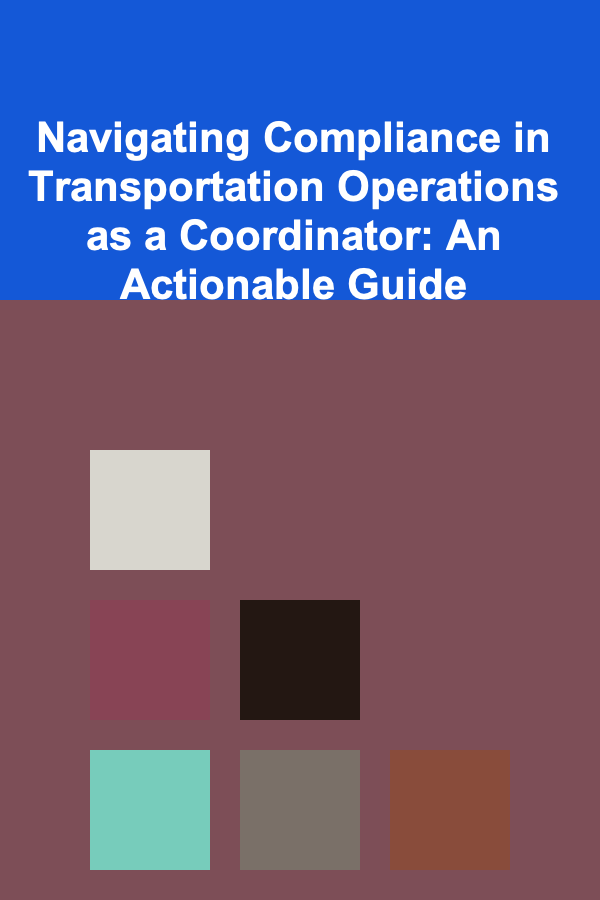
Navigating Compliance in Transportation Operations as a Coordinator: An Actionable Guide
ebook include PDF & Audio bundle (Micro Guide)
$12.99$6.99
Limited Time Offer! Order within the next:

In the fast-paced and complex world of transportation operations, compliance is not just a regulatory requirement; it is a cornerstone of safety, efficiency, and reliability. For transportation coordinators, ensuring compliance across various operations is a multifaceted challenge that requires a deep understanding of regulations, attention to detail, and the ability to manage multiple moving parts simultaneously. This guide will help transportation coordinators navigate the intricacies of compliance, offering actionable steps to ensure adherence to laws and regulations while optimizing operations.
Understanding the Landscape of Transportation Compliance
Before diving into actionable strategies, it's essential to understand the broad range of regulations that govern transportation operations. These regulations can vary significantly based on geography, type of transport, and nature of the goods being transported. However, most compliance requirements fall under the following categories:
-
Safety Regulations
- Includes rules set by organizations like the Federal Motor Carrier Safety Administration (FMCSA) and Occupational Safety and Health Administration (OSHA) in the U.S., as well as local safety bodies worldwide.
-
Environmental Standards
- Regulations such as the Environmental Protection Agency (EPA) guidelines or European Union Environmental Standards focus on emissions, waste management, and fuel efficiency.
-
Driver Qualifications and Hours of Service (HOS) Regulations
- Includes rules related to driver certifications, training, and limitations on driving hours to prevent fatigue.
-
Insurance and Liability Requirements
- Insurance standards ensure that vehicles and shipments are covered in case of accidents or damage during transit.
-
Customs and Import/Export Compliance
- Includes regulatory frameworks that govern the international movement of goods, ensuring proper documentation and tariffs are observed.
-
Vehicle Standards
- Ensures that vehicles meet the required safety and environmental standards to operate legally.
The Role of a Transportation Coordinator in Compliance
As a transportation coordinator, your role is to ensure that your company's transportation operations comply with all relevant local, state, national, and international laws. This involves managing the day-to-day tasks that ensure the entire system---drivers, vehicles, shipments---complies with regulations while remaining cost-effective and efficient.
Key Responsibilities of a Transportation Coordinator in Compliance:
- Regulatory Knowledge: Staying updated on the laws and regulations that apply to different areas of transportation.
- Document Management: Ensuring all required documents (licenses, permits, certificates, etc.) are up to date and readily available for inspection.
- Safety and Risk Management: Monitoring operational processes to ensure safety compliance and mitigating risks associated with violations.
- Driver Oversight: Managing and ensuring that drivers adhere to hours of service, health, and safety guidelines.
- Environmental Compliance: Ensuring that transportation operations minimize environmental impact in line with government regulations.
Actionable Strategies for Navigating Compliance
1. Stay Informed: Constantly Update Yourself on Changing Regulations
Compliance is not static, and regulations can evolve quickly. A transportation coordinator must continuously stay updated with changes in laws and industry best practices.
Actionable Steps:
- Set Up Alerts and News Feeds : Use services like Google Alerts or subscribe to industry newsletters to get real-time updates on new laws and regulations.
- Attend Industry Conferences and Webinars: Join conferences or webinars focused on transportation regulations to stay informed about upcoming changes and industry trends.
- Leverage Regulatory Platforms : Subscribe to regulatory platforms such as FMCSA Portal or EPA's website to get authoritative updates directly from the governing bodies.
- Join Professional Associations : Organizations such as the American Trucking Association (ATA) or the National Association of Transportation Officials (NACTO) offer networking and learning opportunities that keep you informed.
2. Implement a Robust Compliance Checklist
A comprehensive checklist can act as a guide to ensure that every aspect of your transportation operation meets the necessary standards. By breaking down compliance into smaller tasks, you can systematically ensure that nothing slips through the cracks.
Actionable Steps:
- Safety Inspections: Develop a regular inspection schedule for vehicles, ensuring they meet the required safety standards. This includes checking for vehicle condition, brake performance, and lighting systems.
- Driver Certification and Training: Maintain a record of each driver's certifications, training sessions, and compliance with hours of service regulations.
- Permits and Licenses: Keep track of the expiration dates for various licenses, permits, and insurance certificates. Use reminders or automated software to notify you before expiration.
- Environmental Compliance: Ensure that all vehicles adhere to emissions standards and fuel consumption regulations. Regularly audit fuel records to avoid non-compliance with environmental guidelines.
3. Embrace Technology for Efficient Compliance Management
Modern compliance is increasingly driven by technology. Digital tools can automate many of the manual tasks involved in tracking and ensuring compliance. These tools not only save time but also reduce human error.
Actionable Steps:
- Use Transportation Management Software (TMS): A robust TMS can provide tools for route planning, driver scheduling, and tracking compliance. Some TMS solutions include built-in compliance checks to ensure your operations adhere to relevant laws.
- Implement Electronic Logging Devices (ELDs): For compliance with Hours of Service (HOS) regulations, use ELDs to track driver hours automatically. This ensures that drivers do not exceed the maximum driving hours and rest periods.
- Adopt Compliance Management Software : Platforms like Compliance Box or Verizon Connect help track and manage compliance documents, insurance status, and vehicle inspections in real-time.
- Data Analytics and Reporting: Use data analytics tools to monitor trends in compliance, identifying areas for improvement and minimizing the risk of violations.
4. Training and Education for Your Team
Educating your drivers and other team members about compliance requirements is key to maintaining smooth operations. Well-trained employees are more likely to follow safety protocols and adhere to legal regulations.
Actionable Steps:
- Conduct Regular Training: Hold periodic training sessions on topics like safety, handling hazardous materials, and environmental compliance. Use real-life examples to make the training relatable.
- Make Compliance Part of the Culture: Foster a compliance-centric culture within your team. Encourage open communication about compliance issues and ensure that everyone is on the same page.
- Use Simulations and Role-Playing: Use real-world scenarios or simulations to train employees on compliance matters, such as how to handle roadside inspections or manage emergency situations.
- Provide Ongoing Education: Compliance is not a one-time training activity. Offer continuous education through online courses, webinars, or workshops to ensure that your team is up to date on new regulations.
5. Audit and Track Compliance Regularly
Regular auditing and tracking of your operations are essential to ensure that compliance is maintained over time. This is not only a way to prevent violations but also a method of identifying potential issues before they escalate into problems.
Actionable Steps:
- Internal Audits: Schedule quarterly or bi-annual internal audits to check that all processes, vehicles, and drivers are complying with regulations. Audit the compliance of each aspect, from vehicle condition to driver records.
- External Audits: Work with external auditors or third-party compliance experts to provide an unbiased assessment of your compliance levels.
- Track Key Metrics: Use Key Performance Indicators (KPIs) such as incident rates, inspection failures, and driver violations to monitor compliance levels.
- Corrective Actions: When issues are discovered, implement corrective actions immediately. For instance, if a vehicle fails an inspection, schedule repairs and update the maintenance records accordingly.
6. Foster Relationships with Regulators and Industry Bodies
Maintaining open communication with regulators, industry bodies, and insurance providers can help you navigate compliance challenges more effectively. They are valuable resources for advice and guidance in case you encounter complex compliance issues.
Actionable Steps:
- Establish Direct Contacts: Develop relationships with regulatory bodies such as the FMCSA or the EPA. Having a point of contact can expedite responses to inquiries or clarifications on regulations.
- Engage with Trade Associations: By joining associations, you can benefit from their resources, which often include guidance on best practices, lobbying efforts, and regulatory updates.
- Leverage Industry Events: Attend industry conferences, seminars, and workshops where regulators or other compliance experts might share new insights on upcoming changes in the law.
Conclusion
Navigating compliance in transportation operations is a dynamic and complex task that requires constant vigilance, thorough preparation, and proactive management. As a transportation coordinator, your ability to stay informed, leverage technology, and foster a culture of compliance will significantly impact your organization's ability to maintain safety, minimize risk, and avoid costly fines. By implementing a structured approach to compliance, focusing on regular training, using the latest tools, and staying connected with key stakeholders, you can navigate the maze of regulations while ensuring that your operations run smoothly and efficiently.
Reading More From Our Other Websites
- [Personal Investment 101] How to Decode Mutual Fund Expense Ratios and Avoid Hidden Investment Costs
- [Scrapbooking Tip 101] Maintaining and Caring for Your Scrapbooking Scissors: Tips for Longevity
- [Screen Printing Tip 101] Best Tips for Creating Limited‑Edition Screen Printed Art Prints with Collector Appeal
- [Home Maintenance 101] How to Maintain Your HVAC System for Optimal Performance
- [Biking 101] How to Discover the Best Cycling Routes Near You
- [Organization Tip 101] How to Organize Flip-Flops and Sandals for Summer
- [Trail Running Tip 101] Trail Running for Total Body Fitness: Why the Terrain Makes All the Difference
- [Whitewater Rafting Tip 101] Flowing Forward: How the Thrill of Rafting Helps You Embrace Change and Growth
- [Organization Tip 101] How to Organize Vintage Finds by Functionality
- [Personal Financial Planning 101] How to Avoid the 5 Most Common Financial Mistakes: Protecting Your Hard-Earned Money

How to Create Opportunities for Dramatic Play
Read More
How to Keep Essential Office Supplies Within Reach
Read More
How to Train Your Sales Team for Maximum Effectiveness
Read More
Meditation for Better Concentration: A Deep Dive
Read More
Mastering Succession Planting for Continuous Harvests
Read More
Exploring Electric Race Cars and Motorsports
Read MoreOther Products

How to Create Opportunities for Dramatic Play
Read More
How to Keep Essential Office Supplies Within Reach
Read More
How to Train Your Sales Team for Maximum Effectiveness
Read More
Meditation for Better Concentration: A Deep Dive
Read More
Mastering Succession Planting for Continuous Harvests
Read More